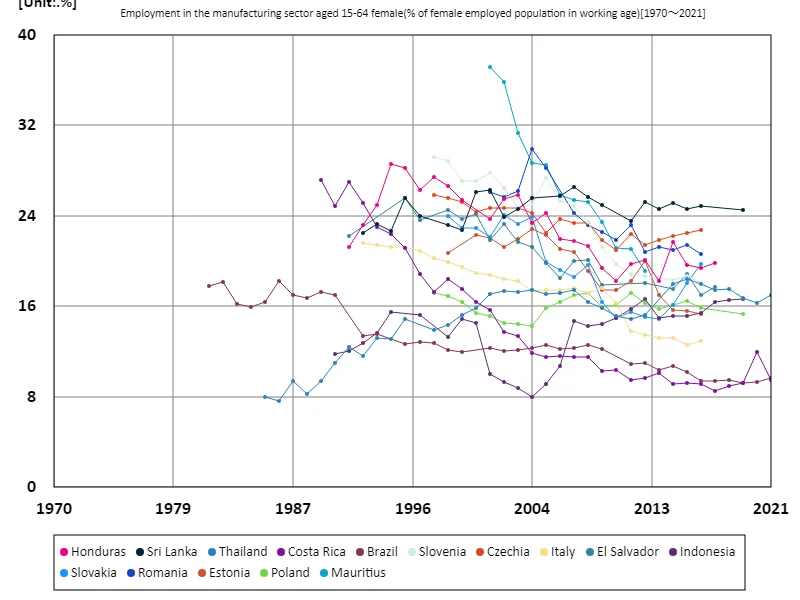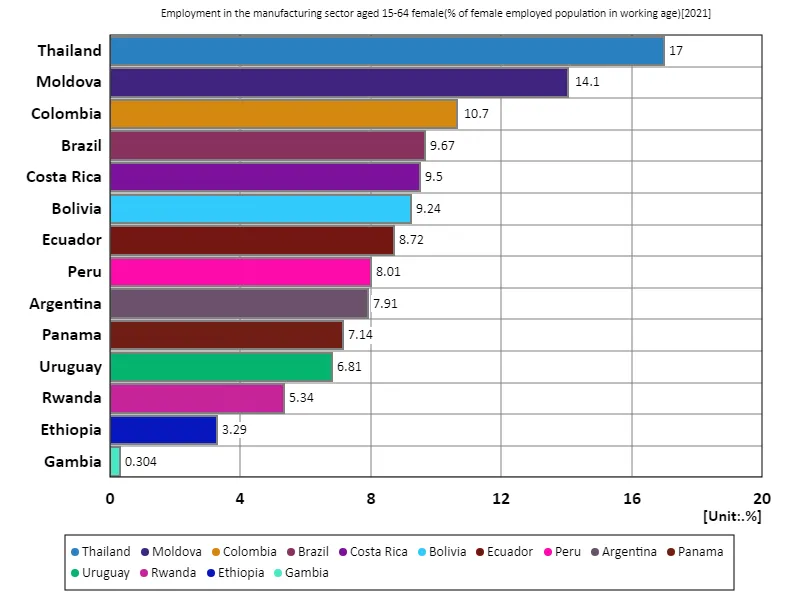- Abstract
- Employment rate in the manufacturing sector for women aged 15-64 (percentage of working-age female employed population)
- Employment rate in the manufacturing sector for women aged 15-64 (percentage of working-age female employment population) (Worldwide)
- Employment rate in the manufacturing sector for women aged 15-64 (percentage of working-age female employment in the labour force) (World, latest year)
- Reference
Abstract
According to 2021 data, the employment rate in the manufacturing sector for women aged 15-64 in Thailand is 17%, high compared to other countries. This high employment rate demonstrates that Thailand’s manufacturing industry is actively recruiting female workers and playing an important role. Thailand is known as a manufacturing hub due to its low-cost labor force, and many international companies have set up production bases there. This is the reason why there are many opportunities for women to work in the manufacturing industry and employment in the manufacturing sector is stable. Compared to other countries, female employment rates in the manufacturing sector tend to be higher in developing countries. In particular, in Southeast Asian countries, manufacturing is a major driver of economic growth and women are widely employed as low-wage workers. On the other hand, in developed countries, the proportion of manufacturing is decreasing and the service industry is becoming mainstream, so the employment rate of women in manufacturing tends to be relatively low. The case of Thailand shows that manufacturing remains a major source of employment and that women play a key role within it.
Employment rate in the manufacturing sector for women aged 15-64 (percentage of working-age female employed population)
Looking at data from 1981 to 2021, we can see that in 2004, Romania had the highest employment rate in the manufacturing sector for women aged 15-64, at 29.9%. However, this proportion has declined significantly in the following decades and currently stands at a peak of 69.1%. This change reflects the evolution of Romania’s manufacturing industry and the changing structure of its economy. At its peak in 2004, Romania was in transition from a communist system to a market economy, with many factories receiving new investments and widely recruiting female workers. However, since the mid-2000s, Romania has joined the European Union and its economy has become more diversified. The decline in the proportion of manufacturing and the growth of the service and IT sectors have led to a decrease in female employment in the manufacturing sector. Furthermore, globalization and increasing automation have also affected the employment structure in manufacturing, leading to a decline in the employment rate of women in the manufacturing sector in Romania. This trend is also being observed in many other developing and Eastern European countries, where the role of female workers in the manufacturing sector is changing as their economies evolve.


The maximum is 29.9%[2004] of Romania, and the current value is about 69.1%
Employment rate in the manufacturing sector for women aged 15-64 (percentage of working-age female employment population) (Worldwide)
Data from 1981 to 2021 shows that in 2001, Mauritius recorded a high employment rate in the manufacturing sector for women aged 15-64 at 37.2%. This percentage has since increased from its peak and currently stands at 51.3%. This indicates that the manufacturing industry in Mauritius has widely embraced female workers and strengthened its role as an important source of employment. As its economy develops, Mauritius has been diversifying its manufacturing industry, with the textile industry in particular becoming a major employer of women. Amidst the ongoing liberalization of the economy and policies to attract foreign investment, the manufacturing sector continues to place a premium on female labor, which has contributed to the increase in employment rates. Mauritius has also focused on education and skills development, encouraging greater female participation in the labour market. While many other countries are seeing a decline in manufacturing employment rates, Mauritius has adopted strategies to retain and increase female employment through manufacturing, highlighting the increasingly important role of women in the local economy. This situation can be seen as the result of efforts to create employment opportunities for women while responding flexibly to changes in the economy.


The maximum is 37.2%[2001] of Mauritius, and the current value is about 51.3%
Employment rate in the manufacturing sector for women aged 15-64 (percentage of working-age female employment in the labour force) (World, latest year)
According to 2021 data, Thailand recorded the highest employment rate in the manufacturing sector for women aged 15-64 at 17%. In comparison, the overall average was 8.4%, making the total figure 118%. Thailand’s high employment rate indicates that manufacturing is an important part of the economy and that many women work in this sector. In Thailand, manufacturing is a major employer of women, especially in sectors such as textiles and electronics. However, the average of 8.4% reflects the fact that in many countries the manufacturing sector is not the main source of employment for women. In developed countries, the proportion of manufacturing is decreasing, and more emphasis is being placed on services and knowledge-based industries. The total figure of 118% suggests that there are large variations in manufacturing employment rates across countries, with higher employment rates in certain countries pushing up the overall average. Employment rates in manufacturing vary widely depending on a country’s economic structure and industry characteristics, as well as the level of female labor market participation, and therefore require detailed country-specific analysis.


The maximum is 17% of Thailand, the average is 8.4%, and the total is 118%



Comments